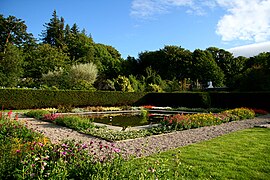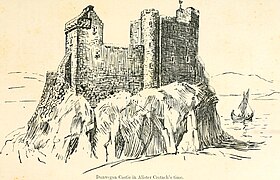Dunvegan Castle
History
The promontory was enclosed by a curtain wall in the 13th century, and a four-storey tower house was built in the late 14th century. This tower was similar in style to contemporary structures at Kisimul Castle and Caisteal Maol. Alasdair Crotach, the 8th chief, added the Fairy Tower as a separate building around 1500. During the 17th century, new ranges of buildings were put up between the old tower and the Fairy Tower, beginning in 1623 with the state apartment built by Ruairidh Mòr. The old tower was subsequently abandoned until the late 18th century, when the 23rd chief began the process of homogenising the appearance of the castle. This process continued under the 24th and 25th chiefs, with the addition of mock battlements and the new approach over a drawbridge from the east. The present appearance of the castle dates from around 1840 when this process of "baronialisation" was completed. The castle is a Category A listed building.
Site
Dunvegan Castle occupies the summit of a rock some 50 feet (15 m) above sea level, which projects on to the eastern shore of a north-facing inlet or bay. On the eastern, landward side of the site is a partly natural ditch around 18 feet (5.5 m) deep.
Artifacts
Notable family heirlooms kept at Dunvegan Castle include:
Images
-
Round Garden, Dunvegan Castle
-
The Walled Garden, Dunvegan Castle
-
Dunvegan Castle
-
Dunvegan Castle entrance
-
Dunvegan Castle port
-
Artist's impression of the castle c. 1500
Literature
The Mystery at Dunvegan Castle a novel by T.L. Huchu is set Dunvegan Castle and the Fairy Flag features in the plot.
References
- ^ Historic Environment Scotland. "Skye, Dunvegan Castle (10835)". Canmore. Retrieved 4 April 2017.
- ^ Historic Environment Scotland. "Dunvegan Castle, approach causeway and bridges (LB501)". Retrieved 4 April 2017.
- ^ "The Mystery at Dunvegan Castle Book Review". Becoming The Muse. Retrieved 5 August 2023.





